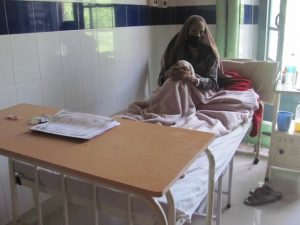As COVID Wanes, Tuberculosis Deaths Must Become Visible
 19 Mei 2022
19 Mei 2022

Tuberculosis has killed 1,5 million people in 2020 – mostly in African and Asian countries – while two million people died of COVID-19 worldwide during the same period. Credit: Athar Parvaiz/IPS
By Angelique Luabeya Kany Kany
CAPE TOWN, South Africa, May 19 2022 (IPS)
It is time to treat the scourge of Tuberculosis scourge with the same urgency as we did the COVID-19 pandemic.
As we emerge from the devastating toll of the pandemic on people’s lives and on global economies, we must wake up to face the staggering toll of 1.5 million Tuberculosis deaths and 10 million new infections recorded in 2020. And these deaths were mostly in African and Asian countries.
These deaths were largely invisible as we fought COVID-19. Even as countries lift COVID-19 restrictions due to declining numbers, we know that Tuberculosis continues to spread.
Access to Tuberculosis care was also hampered by the pandemic restrictions and COVID-19 prioritization on diagnostic and care at healthcare facilities. The World Health Organization (WHO) goal is to reduce new TB cases by 90% and TB deaths by 95% by 2035. We have 13 years left to reach that milestone.
Unfortunately, most people at risk of Tuberculosis are from low- and middle-income countries who will not afford costly vaccines or drugs. The incentive for these big pharma companies to invest in Tuberculosis vaccine development is low.
The harsh reality is that we still don’t have a protective vaccine, and drug resistant TB cases are rising. While research is ongoing, a critical factor hampering progress is the lack of funding. The only TB vaccine available, Bacille Calmette-Guérin (BCG) developed 1920, has limited efficacy.
The relatively quick availability of several vaccines, treatment, and diagnosis for COVID-19 illustrates how billions of dollars in funding can speed up vaccine development against a new deadly disease. For example, the funding available for COVID-19 vaccine development is estimated at 107 billions of dollars while only 0.117 billions available for Tuberculosis.
Yet Tuberculosis has killed 1,5 million people in 2020 – mostly in African and Asian countries – while two million people died of COVID-19 worldwide during the same period. To date, there are 109 vaccine candidates for COVID-19 and only 14 for TB. As noted, we only have one Tuberculosis vaccine while there are 18 vaccines available for COVID 19 .
Tuberculosis research needs at least US$15-billion to have a chance to reach the 2035 target. At the moment, researchers have access to only half of this amount.
Why is funding for a deadly and centuries old disease lacking?
One can argue that Tuberculosis research is too expensive. We have several phases for testing any new drugs or vaccines in clinical trials. Before testing in humans, new drugs and vaccines are tested in animals for adequate safety and immune response. Then there are at least four phases of testing in clinical trials. The next cost implication is that there are several strains of the Tuberculosis bacteria which increases testing costs.
Tuberculosis is a chronic disease with slow progression from infection to disease. Measuring vaccine efficacy requires resources, time and a large sample size of people participating in these studies. These steps increase complexity and cost for Tuberculosis vaccine development. But these costs are small compared to what we spend on COVID-19 research.
Could the reluctance in funding stem from the fact that the Tuberculosis burden falls largely on poor countries in the global South? Tuberculosis is not a pandemic, so the global urge to find a vaccine or drugs is different.
Pharmaceutical companies usually invest in drugs and vaccines from which they can earn profits. Rich countries therefore have other health priorities. Whereas rich countries were impacted by COVID-19, Tuberculosis is largely managed there.
Unfortunately, most people at risk of Tuberculosis are from low- and middle-income countries who will not afford costly vaccines or drugs. The incentive for these big pharma companies to invest in Tuberculosis vaccine development is low.
In the 2016 report of “The catalytic framework to end AIDS, TB and eliminate Malaria in Africa by 2030”, the African union (AU) itself noted that “funding for research and innovation is not prioritized in AU members, intra Africa cooperation lags behind and partnerships are still largely drawn outside Africa”. While external funding is critical, African countries should reinforce and rethink strategies to accelerate Tuberculosis vaccine and drugs development.
As we roll out COVID-19 vaccines and ARVs are made available to HIV patients, we must renew our efforts to do the same with Tuberculosis. Tuberculosis carries a high cost of infection, treatment and death. It is the biggest killer for HIV patients.
African and Asian countries should invest in seeking a vaccine and drug development because they have the heaviest burden. In addition, they must strengthen weak health systems and bolster efforts to identify and adequately treat Tuberculosis cases to stop transmissions.
HIV and COVID-19 pandemics have shown that money can be released when human kind is threatened. The rapid spread of SARS-CoV2 illustrates the fact that the modern world is a global village.
The world should wake up to the rise of microbial resistance that includes Tuberculosis Drug resistant Tuberculosis is a real threat to humanity.
We should not wait for a COVID-like crisis to act. We need to harness the partnerships from this pandemic to prevent another. A world without Tuberculosis feels like a dream. An efficient vaccine can make it come true.
Dr Angelique Luabeya Kany Kany is the Chief research officer at the South African Tuberculosis Vaccine Initiative, University of Cape Town. Dr Luabeya is the Principal investigator of several novel TB vaccines clinical trials, two COVID 19 vaccine trials and diagnostics studies. She is a WHO-TDR Clinical research and development fellow.
